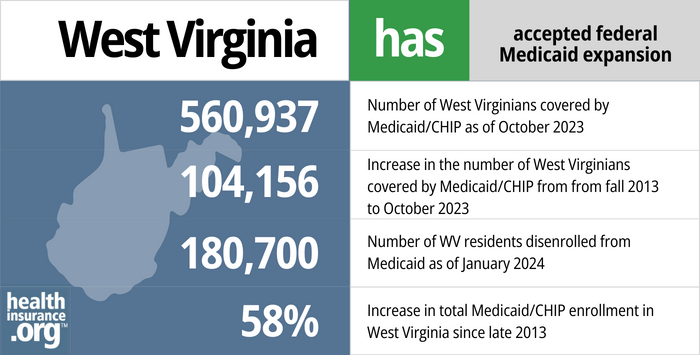
Medicaid eligibility and enrollment in West Virginia
WV Medicaid enrollment is up 80% since 2013, but is expected to decline as disenrollments resume in April 2023 after a three-year pause

Who is eligible for Medicaid in West Virginia?
West Virginia Medicaid is available for these legally present residents, in addition to the aged, blind, and disabled (note that the following income limits include a built-in 5% income disregard that’s used for MAGI-based Medicaid eligibility determinations).
- Infants aged 0 to 1 in households with income up to 163% of the federal poverty level (FPL)
- Children aged 1-5 in households with income up to 146% of FPL
- Children aged 6-18 in households with income up to 138% of FPL
- Children with household income above those levels, up to 300% FPL, are eligible for CHIP in West Virginia
- Pregnant women with income up to 190% of poverty (CHIP is available to pregnant women with income up to 300% of the poverty level). Postpartum Medicaid/CHIP for the mother continues for 12 months after the baby is born.
- Adults with incomes up to 138% of FPL
Pregnant women and children in households with up to 300% of FPL qualify for CHIP in West Virginia (different coverage levels are available depending on income).
for 2026 coverage
0.0%
of Federal Poverty Level
Apply for Medicaid in West Virginia
Apply through HealthCare.gov or by calling 1-800-318-2596 (24 hours a day).
Eligibility: The aged, blind, and disabled. Also, adults with incomes up to 138% of FPL; children with household incomes up to 300% of FPL are eligible CHIP; pregnant women with incomes up to 158% of FPL.

ACA’s Medicaid eligibility expansion in West Virginia
West Virginia’s leaders opted to expand Medicaid under the Affordable Care Act (ACA) starting on January 1, 2014. Under the expanded eligibility guidelines, adults age 19-64 are eligible for Medicaid with a household income up to 138% of the poverty level. For a single adult in 2023, that amounts to $20,120 in total annual income.
CMS reporting shows that West Virginia’s overall Medicaid population grew by 80% between 2013 (pre-ACA) and late 2022. Nearly 641,000 people were enrolled in Medicaid and CHIP in West Virginia as of late 2022, and over a third of that population ( 223,596 people) was enrolled under the ACA’s Medicaid expansion guidelines.
Under the Families First Coronavirus Response Act, states are receiving additional federal Medicaid funding, on the condition that they do not disenroll anyone from Medicaid during the COVID public health emergency period (as described below, the end date for the continuous coverage rule has been set at March 31, 2023). So nationwide Medicaid enrollment has generally trended upward since March 2020.
- 560,937 – Number of West Virginians covered by Medicaid/CHIP as of October 20231
- 104,156 – Increase in the number of West Virginians covered by Medicaid/CHIP from fall 2013 to October 20232
- 180,700 – Number of WV residents disenrolled from Medicaid as of January 20243
- 58% – Increase in total Medicaid/CHIP enrollment in West Virginia since late 20132

Explore our other comprehensive guides to coverage in West Virginia

We’ve created this guide to help you understand the West Virginia health insurance options available to you and your family, and to help you select the coverage that will best fit your needs and budget.
Learn about health insurance coverage options in West Virginia.


In 2023, there is only one insurer offering stand-alone individual/family dental coverage through the health insurance Marketplace in West Virginia.


In 2023, there were 445,699 Medicare beneficiaries in West Virginia.4 Our guide explains Medicare, Medicare Advantage, and the Medigap plans available in West Virginia.


You can buy short-term health insurance in West Virginia for an initial duration of up to 364 days. These plans can be renewed for up to 36 months.
Learn about short-term insurance regulations in West Virginia.

Frequently asked questions about West Virginia Medicaid
How do I enroll in Medicaid in West Virginia?
You can apply for West Virginia Medicaid through the federally-run exchange by visiting HealthCare.gov or calling 1-800-318-2596 24 hours a day.
Or you can apply through the state and that site can also provide SNAP and cash assistance programs for eligible residents.
Medicaid enrollment is year-round: There is no specific time frame during which applications must be completed.
How does Medicaid provide financial help to Medicare beneficiaries in West Virginia?
Many Medicare beneficiaries receive assistance from Medicaid with Medicare premiums, prescription drug costs, and expenses not covered by Medicare – including long-term care.
Our guide to financial assistance for Medicare enrollees in West Virginia includes overviews of these benefits, including Medicaid long-term care coverage, Medicare Savings Programs, and eligibility guidelines for assistance.
How is West Virginia handling Medicaid renewals after the pandemic?
The federal COVID-related continuous coverage rule for Medicaid was in effect for three years, from March 2020 through March 2023. But under the Consolidated Appropriations Act that was enacted in late 2022, the end date for this provision was set at March 31, 2023 (instead of the end of the COVID public health emergency). States have a 12-month “unwinding” period during which they must initiate eligibility redeterminations/renewals for everyone enrolled in Medicaid.
States have the option to begin the unwinding period in February, March, or April 2023, with disenrollments resuming roughly two months later for people who are no longer eligible or who fail to respond to a renewal information request. West Virginia opted to begin right away, with renewal notices sent out starting in February 2023, and the first round of disenrollments in April 2023.
(West Virginia has continued to process eligibility redeterminations throughout the pandemic, but did not disenroll anyone who was no longer eligible or who didn’t respond to the renewal notice. So the renewal notices that went out starting in February 2023 were the first that could result in disenrollment since before the pandemic.)
West Virginia’s Medicaid unwinding plan can be seen here, FAQs are here, and renewal/disenrollment data will be updated on this page throughout the unwinding period. Roughly 7% to 10% of the state’s total Medicaid population will have their eligibility redetermined each month during the unwinding period. A person’s Medicaid will continue until their renewal date, even if they are no longer eligible. So some people (who are no longer Medicaid-eligible) will still keep their Medicaid coverage until late 2023 or early 2024, depending on when their renewal is processed.
Most of the people who lose Medicaid will be eligible for employer-sponsored health coverage or for a subsidized plan through the West Virginia exchange/marketplace (HealthCare.gov). Enrollment windows for employer-sponsored coverage are time-limited. HealthCare.gov is offering an extended 16-month enrollment window for people who lose Medicaid during the unwinding of the Medicaid continuous coverage rule, but it’s still important to enroll in a new plan before Medicaid ends, to avoid a gap in coverage. There is also a special enrollment period during which people who have become eligible for Medicare can transition from Medicaid to Medicare without late enrollment penalties.
Legislation impacting West Virginia Medicaid
West Virginia lawmakers consider Medicaid buy-in and Basic Health Program
In 2023, legislation is under consideration in West Virginia that would create a Basic Health Program (available to people ineligible for Medicaid but with income up to 200% of the poverty level) and possibly a Medicaid buy-in program that would allow people to purchase Medicaid coverage if they don’t meet the income guidelines for the program.
H.B.3274, which passed in the House in late February, initially called for the creation of both programs, but the revised version that was approved by House lawmakers calls for just the creation of a Basic Health Program. S.B.610, which had not yet had a vote in the Senate as of late February, calls for the Basic Health Program as well as Medicaid buy-in.
West Virginia CHIP expanded to include pregnant women; postpartum Medicaid/CHIP coverage extended to 12 months
SB564 was signed into law in West Virginia in 2019. The legislation called for CHIP coverage in West Virginia to be expanded to include pregnant women. CHIP eligibility for kids in West Virginia already extended to households with income up to 300% of the poverty level, and that’s the same level that now applies to pregnant women as well. The new CHIP coverage for pregnant women took effect on July 1, 2019 in West Virginia.
Only five other states (Colorado, Missouri, New Jersey, Rhode Island, and Virginia) provide CHIP coverage to pregnant women, but there are numerous states with fairly high income limits for pregnant women to qualify for Medicaid (for example, Medicaid coverage is available to pregnant women in Iowa with household income as high as 375% of the poverty level; in DC, it’s 318%).
And starting in 2022, West Virginia extended postpartum Medicaid/CHIP coverage to 12 months, so a person who is pregnant and covered under Medicaid or CHIP can keep that coverage for 12 months after giving birth, instead of having their coverage end 60 days post-birth. Federal rules only require 60 days of postpartum Medicaid coverage, but the American Rescue Plan provided additional federal funding for states to extend this to 12 months (that was temporary, but the Consolidated Appropriations Act enacted in late 2022 made it permanent) and most states have chosen to do so.
West Virginia considered a Medicaid work requirement
As of late 2017, West Virginia’s Department of Health and Human Resources was considering the possibility of seeking a waiver from the federal government in order to implement a work requirement for the state’s Medicaid expansion population. Legislation (HB3136) to create a work requirement was considered in the 2019 legislative session, but it was criticized by consumer advocates and did not advance to a vote.
Although work requirements were a non-starter with the Obama administration, the Trump administration approved them in several states. But the work requirements were either overturned by judges or suspended due to the COVID pandemic, and all of the approved work requirement waivers were revoked by the Biden administration.
Medicaid expansion helping to combat opioid crisis
The opioid crisis has hit West Virginia particularly hard, and the state has the nation’s highest drug overdose death rate. About 22,000 people covered under expanded Medicaid had received treatment for mental health and substance abuse disorders by early 2017. Without Medicaid expansion, most of those people would have been uninsured and unable to access treatment.
Previous and current governor support Medicaid expansion
West Virginia’s former Governor, Earl Ray Tomblin, was instrumental in West Virginia’s acceptance of Medicaid expansion but was term-limited and could not seek re-election in 2016.
Governor Jim Justice took office in January 2017. He campaigned and was elected as a Democrat, but in the summer of 2017, during his first year in office, he switched to the Republican party. Justice reiterated his support for Medicaid expansion in the weeks leading up to his party switch, stating in late June 2017 that it would be “beyond catastrophic” if the people who had gained coverage under Medicaid expansion were to lose it. But Justice also vetoed a supplemental appropriation for the state’s Medicaid program in 2019, saying that the Medicaid program already had enough funding.
Substantial impact on uninsured rate
Expansion of Medicaid has played a primary role in West Virginia’s sharp reduction in the uninsured rate. According to a 2014 Gallup survey, West Virginia had the sixth-highest drop in uninsured rate during the first half of 2014, due primarily to Medicaid expansion.
According to U.S. Census data, the state’s uninsured rate was 14% in 2013, and had fallen to 5.3% by 2016. But it had increased to 6.7% by 2019, however, mirroring the nationwide trend of increasing uninsured rates under the Trump administration.
West Virginia’s uninsured rate had been similar to the U.S. average (14.5%) in 2013, but the state’s uninsured rate in 2019 was well below that national average at that point, which was 9.2%. West Virginia’s better-than-average performance in reducing the uninsured rate was due in large part to the expansion of Medicaid.
West Virginia Medicaid enrollment numbers
Medicaid expansion initially significantly exceeded the 93,000 people that West Virginia had projected to enroll by 2020 under the expanded eligibility guidelines (note that the Kaiser Family Foundation had put the estimate for newly eligible West Virginians higher, at 143,000 people), but enrollment declined after peaking in 2016. The total number of people enrolled under expanded Medicaid declined slightly by January 2017, to 174,026, and declined further, to 165,917, by March 2018.
But it had grown to 223,596 by 2022, due in large part to the COVID pandemic and the continuous coverage requirement that was in effect from March 2020 through March 2023. Medicaid enrollment in West Virginia grew by 80% between 2013 (pre-ACA) and late 2022. Over 638,000 people were enrolled in Medicaid and CHIP in West Virginia as of late 2022, with about a third of those people enrolled Medicaid expansion guidelines.
Opponents of Medicaid expansion predicted that states with a surge in Medicaid enrollment would find that Medicaid patients were unable to get appointments for primary care, but West Virginia doctors weren’t indicating that was a problem when enrollment initially spiked. Instead, some of their challenges include a significant population of newly-insured people who are requesting pain medication at office visits, and patients who have previously been on free drug samples and need to be switched to another drug that’s covered by Medicaid. Despite the unexpectedly large enrollment in Medicaid expansion — combined with the fact that the state began paying a portion of the Medicaid expansion costs starting in 2017 — West Virginia’s Medicaid budget had a surplus as of early 2019.
Uncompensated care costs decline sharply
According to data compiled by West Virginians for Affordable Health Care, hospitals in West Virginia saw a 40% decline in uncompensated care costs from 2013 to 2014, thanks in large part to Medicaid expansion that resulted in far fewer uninsured residents in the state.
But although the hospitals acknowledge that their uncompensated care and charity care costs have declined significantly, some also note that Medicaid reimbursements are less than the cost of providing care, and that their losses on Medicaid volume are offsetting the improvements they’ve seen in uncompensated care.
West Virginia’s Medicaid expansion history
West Virginia had initially considered setting up a state-run exchange, but later opted for a partnership exchange, citing cost as one of the reasons for avoiding a fully state-run exchange.
State leaders have said that given the choice between a state-run exchange and Medicaid expansion, the latter seemed like it would provide more bang for the buck (and judging by the state’s extremely successful Medicaid enrollment in 2014, it would appear they were correct).
In May 2013, then-Governor Earl Ray Tomblin announced that West Virginia would proceed with Medicaid expansion. Enrollment for newly-eligible residents began on October 1, 2013, with coverage effective January 1, 2014.
Footnotes
- “October 2023 Medicaid & CHIP Enrollment Data Highlights”, Medicaid.gov, Accessed November 2023 ⤶
- “Total Monthly Medicaid & CHIP Enrollment and Pre-ACA Enrollment”, KFF.org, Accessed November 2023 ⤶ ⤶
- ”West Virginia Medicaid, Public Health Emergency and Unwinding the Continuous Eligibility“, West Virginia Bureau for Medical Services, Accessed November 2023 ⤶
- “Medicare Monthly Enrollment” CMS.gov, April 2023 ⤶

